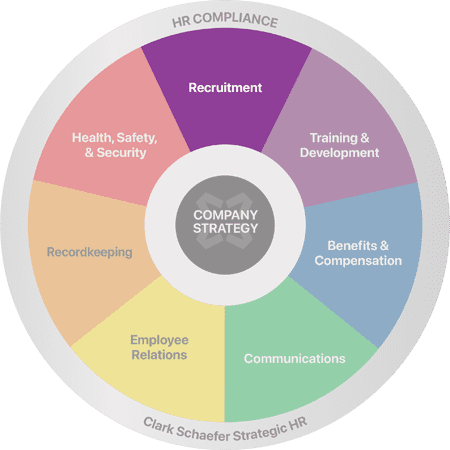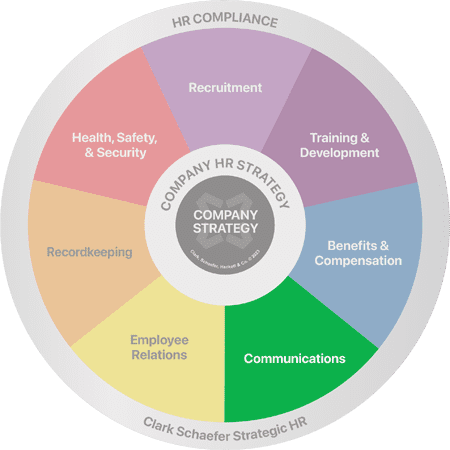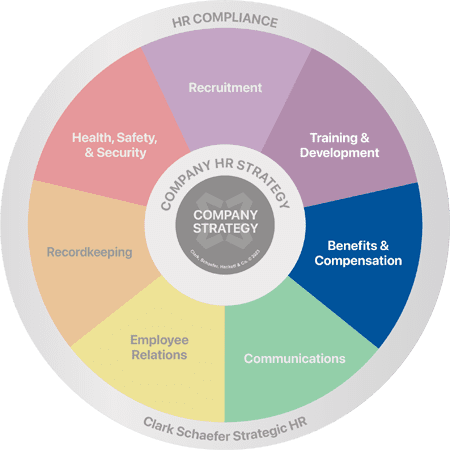Posts
Building A DEI&B Roadmap
Last Updatedin HR Strategy

When considering how to implement a diversity, equity, inclusion, and belonging (DEI&B) roadmap, many organizations may feel intimidated. It can feel like a mountain to climb when it comes to the sheer number of possibilities, programs, and efforts that you can undertake.
So, what’s a measured and structured way of implementing (or evaluating already established) DEI&B programs within your organization? We will share our recommendations for the steps you can take to develop your program objectives and goals, as well as how to create a Cultural DEI&B Roadmap to help you on this journey.
Step 1: Understand Your Purpose & Define Your Vision
The first step is to identify and define the overall purpose of your DEI program. For example, is your organization considering the program to remain on par with competitors in the market? Is the ultimate objective to establish and nurture an inclusive culture? Or potentially, is a DEI&B program on your radar because the organization lacks the diversity that you would like to see compared to the surrounding community?
There could be many reasons behind it – it could include all the reasons listed above, and more! Whatever your reasons for developing DEI&B programming, they should inform your program goals and objectives.
Step 2: Define Your Strategic Objectives
Before you can effectively build a plan for where you want to go, you must first understand where you currently are. To do this, you will need to do a statistical analysis to understand the makeup of your current workforce by analyzing employee data from your HR information system (HRIS) and/or payroll system. We also highly recommend conducting a confidential employee survey to gather honest feedback on your organization’s DEI&B status.
Once you’ve gathered the data and have a better picture of what your organization’s DEI&B landscape looks like, it’s important to establish a SMART (Specific, Measurable, Actionable, Realistic, and Timebound) goal to drive your strategic objectives. An example goal could be, “In order to accurately reflect the diversity of our community and to position ourselves as an employer of choice, we want to increase our organization’s racial diversity by 20% in the next three years.”
That’s a great goal! Now how do you achieve that?
Step 3: Create a DEI&B Cultural Roadmap
To build a comprehensive DEI&B roadmap to meet your goal, you have to define the strategic objectives that you will use to get there. To define those objectives, you should consider four key pillars: Attract, Belong, Promote, and Influence. Each pillar holds up a different aspect of a comprehensive DEI&B plan and together will help you to develop a cultural DEI&B roadmap.
There are four main pillars in DEI&B Cultural Roadmaps:
- Attract – Recruiting a diverse workforce – talent acquisition management
- Belong- Employee engagement, belonging, and retention
- Promote – Career pathing, career progression, learning & development, and succession planning.
- Influence – how are we operating an organization within our community and within the world? Includes community relations and volunteer opportunities. Includes do you have a DEI-focused vendor list?
You MUST include all 4 pillars, or your efforts will fall down just as a three-legged chair. And each one of those pillars, what we do is we roll up various initiatives underneath each one of those pillars over a several-year road map in order to get where we want to go long term.
Attract
If your goal is to increase the diversity of your workforce, it may seem obvious that you will need to attract a more diverse pool of talent. But how can you do this? An excellent place to start is by reviewing your job descriptions and scrutinizing whether any of your current requirements detract diverse candidates from applying. For example, are the education, background, and day-to-day requirements absolute “need-to-haves”, or are you willing to be flexible? Could your requirements be open to experience in exchange for formal education? Do they have to have a driver’s license, or do you just need to confirm that they have reliable transportation to and from work?
Belong
Belonging is one of the newer concepts to enter the diversity, equity, and inclusion conversation, but it requires no less attention. By appropriately promoting and creating the paths for promotion for our diverse team members, it allows team members of any background to see the potential for themselves in roles they may not have had access to before.
If they can see someone who looks like them, thinks like them, operates like them, lives like them in a high-achieving role, it can make an incredible impact. Or, if a high-level role isn’t attractive to some individuals, we can still achieve a sense of belonging by engaging mentors and advisors to help guide and educate our team. Having those individuals in our professional lives that have similarities with us, whether that’s culturally, physically, spiritually, or otherwise, can make it a lot easier for people to be motivated and incentivized to engage and remain with the organization.
Promote
So, how can your organization promote diverse candidates internally if your organization is already lacking diversity? Minority entities and groups of individuals who haven’t had the same access to opportunities may already be at a disadvantage when considering growing through the company.
How can the organization provide access to training or education to allow these groups the opportunity to grow within and through the company? Promoting from within requires this key action.
And while promoting from within requires a longer timeline in comparison to attracting diverse talent (potentially three years versus a couple of months), this action will set your organization up for success in the long run. If you’re looking for a truly successful promotion-from-within strategy, be prepared to take steps in these initiatives over five to ten years. Tactics for this strategy can look like career pathing and building lines of succession. By taking smaller steps towards inclusion under the “promote” pillar, you’re creating an even more inclusive environment that will retain the diverse talent that you worked so hard to attract.
Influence
When we consider “influence,” we may initially assume that we’re hoping to influence internally – whether that’s decision-making, culture, or inclusive conversations. And while those are absolutely areas that we should consider and impact through this process, the concept of “influencing” through your DEI&B roadmap actually applies outside of the organization. It involves asking questions such as “How can we show the community that we live and/or operate in that we promote and encourage and support particular minority groups?” Is it engaging in Black History Month, Asian American and Pacific Islander Month, Native American Heritage Month, Hispanic Heritage Month, Pride, or more? And is that engagement something that we (as an organization) can continue year-round?
This external “influencing” goes hand-in-hand with attracting diverse team members – by getting involved and positively impacting community groups, then you’re positioning yourself as an employer of choice.
A successful DEI&B roadmap takes time, effort, planning, and funds. Whether your organization is still in the foundational stages of building a DEI&B program or reevaluating previously made goals for your current program, a roadmap can help guide the key players towards success in achieving the strategic level goals.
Special thanks to Mary Mitchell, MBA, SPHR, SHRM-SCP, CHRS, and Samantha Kelly for sharing their expertise in this article!
Building a comprehensive and inclusive diversity, equity, inclusion, and belonging plan can improve team morale, create a welcoming work environment, and position your organization as an employer of choice in a difficult labor market. If you need assistance or guidance in building this plan, visit our DEIB Consulting Services page or contact us today!
What Are Stay Interviews and What Questions Should I Ask?
Last Updatedin Communications

HR Question:
Can you explain stay interviews – what are they? How should we use them and what should we ask?
HR Answer:
Not to be confused with exit interviews (meant for seeking to understand why departing employees are leaving), stay interviews are a great tool to understand why your employees choose to stay with your organization. They can also help to uncover potential areas of concern that may cause employees to leave if not addressed. Conducting stay interviews shows that you care about employees’ experiences and gives you the opportunity to make changes to retain your most valuable asset – your employees.
Who should participate?
Start with your end goal in mind. Consider why you’re conducting stay interviews and what you want to learn. This will help to determine who should participate. Some organizations may choose to focus on a particular department, a company location, or high performers. Others choose to conduct company-wide stay interviews. There’s not necessarily a right or wrong answer here.
Choosing Stay Interview Questions
Stay interviews typically consist of five to six questions, with at least one question that is quantifiable (i.e., rating satisfaction using a 5 or 7-point Likert scale) while leaving the others open-ended. The quantifiable questions provide a quick way to measure and easily report on employees’ attitudes, opinions, or perceptions of an aspect of work or the work environment. We recommend following quantifiable questions with asking why they chose their answer for additional insight.
Sample quantifiable questions:
- Would you recommend working here to a friend?
- Do you have the resources that you need to do your job effectively?
- Do you have clear goals and objectives?
- How happy are you to come to work every day? (Use a 5-point answer scale)
On the other hand, open-ended questions dig deeper into your employees’ thoughts, feelings, and experiences. These answers can reveal themes of what is going well and shed light on what can be improved to encourage employees to stay.
Sample open-ended questions:
- What do you look forward to when you come to work each day?
- What do you like most or least about working here?
- What are your favorite aspects of your job? Least favorite?
- If you could change something about your job, what would that be?
- What would make your job more satisfying?
- How do you like to be recognized or rewarded?
- What skills/talents are you not currently using at work?
- How can we best support your learning and development?
- What motivates (or demotivates) you?
- What might tempt you to leave?
- What can your manager do more of or less of to best support you?
Choose your questions carefully to ensure they help you to learn what you really want to know. It is okay to go into this process with some assumptions about what is and is not going well. The right questions can help you tease out whether your assumptions are correct. Sometimes addressing the “elephant in the room” is exactly what needs to be done. In other situations, the right questions can reveal issues that you weren’t even aware existed.
Selecting the Best Approach
Once you’ve identified who you want to include in the process and what you want to ask, your next steps are to determine the where, when, and how.
Location
Stay interviews can be conducted in person or virtually. Keep in mind that it is important to maintain privacy and confidentiality when selecting where to host the conversations. If conducted in person, be sure to select a location that is private and away from where others could overhear the conversation.
Timing
If you use five to six questions, they typically can be completed in less than thirty minutes. You can consider conducting stay interviews once a year or more frequently, depending on your needs.
Establishing Trust
It is essential to establish a feeling of psychological safety and trust so that employees feel comfortable being honest and open in sharing information. It is best for the data collection to be anonymous with results reported in summarized themes that are not traceable back to specific individuals. There should be no worry of retribution for sharing their thoughts and opinions. As a result, you’ll want to choose your interviewer(s) carefully.
Many organizations choose to have stay interviews conducted by independent outsourced experts who can guide them through the entire process of participant selection and question development, as well as conducting the interviews and providing follow-up data reports and recommended actions. Independent consultants can apply an unbiased approach throughout the entire process. This often leads to more robust data and action plans as employees are more willing to open up and talk.
The Key to Productive Stay Interviews
Hopefully, it goes without saying that you must go into this process prepared to react to what you learn. Employees are typically excited to have their voices heard. They will be anxious to see what you do with the information they have shared. It would be quite ironic if a lack of acknowledgment of their feedback would lead to employees feeling devalued and choosing to leave.
At the same time, it is unrealistic, and in most cases unnecessary, to address every concern that is raised. There will inevitably be outlier comments in the information collection process that only apply to one specific person or don’t seem to be significant for the broader good of your organization.
Be Transparent
You can position the process for success with clear and transparent communication from beginning to end. Well in advance of the stay interviews, make sure that you have communicated your intentions of conducting the interviews, why you are doing them, and the expected timing of the interviews. Particularly if you are using outsourced HR experts to facilitate the interviews, be sure that employees know who these folks are and what to expect.
In addition, manage employees’ expectations on the front end and throughout the process regarding how you plan to handle what is learned. It is fair and reasonable to say that you don’t expect to be able to solve all of the concerns that may be shared, but you are committed to learning from their perspectives and making some improvements.
Showing that you are committed to listening and taking action to strengthen your organizational culture will go a long way in increasing your employee engagement and their desire to stay.
Thank you to Melinda Canino and Alisa Fedders, MA, SPHR, Manager of Business Advisors, for contributing to this HR Question of the Week.
Are you left wondering why employees choose to stay or leave your organization? Our experts at Clark Schaefer Strategic HR can design and conduct independent, unbiased stay or exit interviews as well as employee surveys, pulse surveys, and more to assess employee satisfaction and engagement. Learn more about how we can help on our HR Communications page or simply contact us today!
How Can We Reduce Bias in Recruitment Processes?
Last Updatedin Recruitment
Designing a Modern Dress Code for Today’s Workplace
Last Updatedin Communications

HR Question:
We’re taking a look at revising our dress code policy. We want to balance today’s increasingly casual approach while still asking our team members to look professional. How can we create a modern dress code policy?
HR Answer:
In today’s modern workplace, the concept of dress code has evolved to reflect a more relaxed and individualistic approach. Many companies have moved away from the traditional suit, skirt, button-down, formal shoes, tie, etc. combinations that were common in the past. One of the main reasons for this shift is the changing nature of work itself.
Many jobs today are more creative and require a more individualistic approach. This means that employees are encouraged to express themselves through their clothing choices, as long as it is appropriate for the workplace. Additionally, as younger generations gain a larger presence in today’s workforce, employers have recognized the need to allow for personal expression through clothing and accessories with a lean toward a more casual dress code to attract and retain top talent.
Designing a dress code for the modern workforce is an important task and requires a delicate balance between creating a professional and inclusive environment. Here are some steps to consider when designing a dress code:
Identify your Dress Code Requirements
First, identify the requirements of your workplace, including the nature of the work, the industry, workplace safety, and the expectations of the customers or clients. It might help to categorize your approach in typical dress code categories that most individuals are familiar with, such as business casual, casual, smart casual, company attire/uniform, and business attire.
For those unfamiliar with those guidelines, providing examples is your best route to clearly outline expectations. For example, you could provide images or descriptions of appropriate attire and accessories. These examples will guide the type of attire that is appropriate for your workplace.
If the nature of an employee’s work and who they interact with varies daily (i.e., Are they customer-facing all of the time? Some of the time? Not at all?), that may result in the expectations for their level of dress to change from day to day depending on these factors. So if your dress expectations do vary, we recommend that you clarify this in your dress code policy to help employees navigate through this appropriately.
Make Sure It’s Inclusive
It’s important to balance the need for professionalism with the desire (or need, in some cases) for individual expression, respect for other cultures, and/or the way individuals identify. For example, establishing expectations or limits around how someone wears their hair could limit someone’s ability to abide by their religious beliefs or could discriminate against hairstyles that have cultural significance. For example, The C.R.O.W.N. Act was created for this very reason.
Developing an inclusive dress code should also factor in gender identity. Avoid gender-specific language and instead use gender-neutral language, such as “employees should wear professional attire, such as a suit and tie or skirt and blazer” instead of “men should wear a suit and tie.”
Be Flexible & Seek Feedback
Flexibility is key when designing a dress code that is inclusive of all genders. Consider allowing employees to choose from a range of acceptable attire options, rather than prescribing a specific dress code. If your organization maintains a uniform (ideally, one that can be considered gender-neutral), consider allowing employees to express themselves through accessories or subtle variations in attire, while still maintaining an appropriate level of professionalism.
Finally, seek feedback from employees to ensure that the dress code is meeting their needs and is inclusive of all genders. Encourage open communication and consider making adjustments as needed.
Overall, designing a dress code for the modern workforce requires a thoughtful and inclusive approach that balances professionalism and individual expression. While there are still certain expectations and guidelines that should be followed, employees are encouraged to express themselves through their clothing choices. By understanding your workplace culture and asking employees to dress appropriately for their positions, you can help them find and maintain a healthy balance between professionalism and self-expression.
Thanks to Cassie Whitehouse, M.Ed., for contributing to this edition of the HR Question of the Week!
Trying to find ways to create inclusive policies? Want to build a welcoming environment, but not sure how to develop policies and procedures that reflect that? Our team at Strategic HR can help you create policies and procedures that clearly lay out your expectations of your employees while creating a flexible and inclusive environment. Contact us today or learn more about how Strategic HR can help you remain compliant, avoid unnecessary obstacles, and increase employee trust, engagement, and satisfaction through HR Communications.
What is Equal Pay Day?
Last Updatedin Benefits & Compensation

HR Question:
I keep seeing information about “Equal Pay Day” during Women’s History Month. What is Equal Pay Day, and how can I recognize it in my organization?
HR Answer:
Equal Pay Day is a symbolic day that puts into perspective the 23% pay gap between a woman and a man in the same role. Based on the current gap, a woman has to work one full year plus several additional weeks into the following year to make the same amount that her male counterpart made in one year alone.
In 2023, Equal Pay Day is March 14, representing the 2022 US Census Data showing women make 84 cents (all full-time workers) and 77 cents (all full-time, part-time, and seasonal earners) for every dollar paid to non-Hispanic, white men. This translates to an annual wage gap of $9,954. That gap is unfortunately even larger for most women of color, resulting in a gap of $.64 on the dollar for Black women, $.62 for mothers, $.61 for Native Hawaiian and Pacific Islanders, $.54 for Latina women, and $.51 for Native and Indigenous women.
Equal Pay Day was established in 1996 by the National Committee on Pay Equality (NCPE). The day is recognized annually, but not always on the same date due to the pay gap calculation. Even though Equal Pay Day has been around for 27 years, it is more widely recognized today, in part due to the stronger focus on eliminating the gap. Current initiatives, such as pay transparency and salary history ban laws, were introduced by individual cities and state-wide to address the pay gap.
Where are Equal Pay Laws in Place?
On January 1, 2023, three new states were added to the list of city and state governments that passed laws to protect applicants by banning employers from asking about prior salary history and/or requiring that companies list salary ranges in their job advertisements. Currently, the following governments have such laws:
States:
- California
- Colorado
- Connecticut
- Maryland
- Nevada
- Rhode Island
- Washington
Cities:
- Cincinnati, OH
- Ithaca, NY
- Jersey City, NJ
- New York City, NY
- Toledo, OH
- Westchester County, NY
According to the Society for Human Resource Management (SHRM), pay transparency is one of the top issues people managers will face in 2023. According to Monster’s 2022 poll, 98% of workers believe salaries should be disclosed, with another 53% of applicants refusing to apply for a position if the salary is not disclosed.
How Can I Support the Movement?
So how can employers address the gender gap and honor Equal Pay Day in their organizations? Some recommended ways include:
- Performing an Equal Pay Audit to review job classifications, salaries, and genders and take corrective actions if inequity is found.
- Reviewing compensation policies to remove gender bias.
- Removing managerial discretion on pay and sticking to a salary band of positions for new hires and for annual increases.
- Removing prior salary history from applications and interviews.
- Establishing fair scheduling practices to allow for caregiving.
For even more ways to contribute to awareness and celebrate Equal Pay Day you can visit equalpaytoday.org.
Thank you to Paula Alexander, MA, PHR, SHRM-CP, for contributing to this HR Question of the Week!
Performing an equal pay audit can be a complex, but necessary, step toward equal pay for all. Clark Schaefer Strategic HR is ready to assist you with any of your needs around Benefits and Compensation. We offer assistance with everything from job descriptions to policy development to help address your complex issues that impact employee compensation or benefits. Please visit our Benefits and Compensation page for more information on how we can assist you.
Are You Ready For These Top HR Trends in 2024?
Last Updatedin HR Strategy

As we transition into a new year, the world of Human Resources is poised to undergo several transformative trends that reflect the evolving landscape of work. Some transformations are already at work, such as the continued integration of technology in HR processes, with the adoption of artificial intelligence (AI), data analytics, and automation tools. These technologies are not only streamlining administrative tasks but also enhancing decision-making processes, enabling HR professionals to focus on more strategic and value-added activities.
Additionally, an emphasis on employee well-being is gaining momentum, with organizations recognizing the importance of creating a positive work environment that promotes mental health, work-life balance, and overall job satisfaction. Our team anticipates that remote and hybrid work arrangements will persist, prompting HR departments to refine policies and practices to accommodate diverse and flexible work setups that continue to support a diverse workforce with varying needs.
And finally, we expect diversity, equity, inclusion, and belonging initiatives will also remain at the forefront of the HR landscape, as companies strive to create more inclusive and equitable workplaces. DE&I efforts go hand in hand with employee well-being and employee satisfaction. As employers work to foster diverse and inclusive workplaces, they are also challenged to be highly transparent in their communications and actions and to build a high level of trust, which leads to employee satisfaction and retention.
So how do we expect to see these HR trends play out in the coming year?
Generative AI & Upskilling
In a June 2023 survey by Gartner, 81% of HR leaders have already begun to explore and implement AI solutions within their organizations, with 52% exploring potential use cases and opportunities for generative AI. Indeed, the Future of Jobs Report 2023 indicates that by 2027, 43% of work tasks will be automated.
The Future of Jobs Report also emphasizes the growing focus on cognitive skills within the workforce – skills like creative and analytical thinking, technology, literacy, and socio-emotional attributes such as curiosity, resilience, and lifelong learning.
Upskilling in the field of human resources is expected to become increasingly important in the coming years and will play out in a variety of ways:
1. Technology Integration
The HR field is becoming more technology-driven with the adoption of complex HRIS (Human Resource Information Systems), AI-driven tools, and data analytics. HR professionals will need to quickly upskill to effectively utilize these technologies and leverage artificial intelligence for HR tasks such as recruitment, employee engagement, and talent management and development.
As HR professionals explore ways to weave AI into their daily operations, it’s also important to understand the ethical and legal concerns of AI adoption.
2. Data-Driven Decision-Making
HR professionals are increasingly relying on data to make informed decisions in areas such as workforce analytics, recruiting, employee performance, and strategic planning – even more so with the rise of AI. Consider providing data analytics training opportunities to help employees successfully engage and understand the results these technologies can provide.
3. Soft Skills and Emotional Intelligence
With the rise of remote work and digital collaboration, the importance of soft skills and emotional intelligence will continue to be sought after. HR professionals need to be adept at interpersonal communication, empathy, and understanding diverse perspectives – especially when so much interpersonal context is lost from behind a screen. Upskilling in these areas will be vital for effective employee relations, conflict resolution, and fostering a positive workplace culture.
4. Continuous Learning Culture
HR professionals should model and promote a culture of continuous learning within organizations. Reevaluating learning and development strategies, assessing training methodologies, and implementing ideal learning technologies will be essential to support the professional as well as personal growth of employees.
In summary, learning to utilize AI in beneficial ways, as well as upskilling across organizations, will create a mix of technical, interpersonal, and leadership skills that help employees adapt to the evolving workplace landscape and allow HR leaders to contribute to the success of organizations in highly valued ways.
Employee Well-Being
Companies are increasingly recognizing the importance of employee well-being. The employee well-being umbrella includes mental health support, work-life balance and remote work initiatives, and wellness programs, in addition to providing meaningful work and opportunities for learning and development. The expectations of employers are growing by the minute!
The top 5 ways employers can support employee well-being in the upcoming year include a combination of physical, mental, and professional support:
1. Flexible Work Arrangements
Offer flexible work hours and remote work options to accommodate diverse employee needs. A flexible work environment allows employees to better balance their professional and personal lives, reducing stress and enhancing overall well-being. To learn more, check out Gallup’s article, “The Future of the Office Has Arrived: It’s Hybrid,” as well as Techopedia’s Remote Work Predictions for 2024.
2. Mental Health Programs and Resources
Prioritize mental health by providing access to counseling services, mental health workshops, and Employee Assistance Programs (EAPs). Promote a culture of openness and destigmatize mental health issues to encourage employees to seek help when needed.
3. Professional Development Opportunities
Invest in employees’ professional growth by offering training programs, workshops, and opportunities for skill development. Providing clear pathways for career advancement and continuous learning not only enhances employees’ job satisfaction but also contributes to their overall well-being.
4. Health and Wellness Initiatives
Implement comprehensive health and wellness programs that address physical well-being. This can include fitness classes, wellness challenges, health screenings, and initiatives that promote a healthy lifestyle. Consider providing wellness benefits such as gym memberships or wellness reimbursements.
5. Regular Check-ins and Feedback
Conduct regular one-on-one check-ins between managers and employees to discuss workloads, career goals, and any challenges they may be facing. Foster open communication and create a supportive environment where employees feel comfortable sharing their concerns.
Check-ins allow for the opportunity to course-correct, as needed, and to ensure that employees have the resources they need to do their jobs successfully. In addition, providing constructive feedback and recognition for accomplishments contribute to a positive work experience.
These strategies collectively address various aspects of employee well-being, creating a holistic approach that considers both personal and professional needs. Employers need to tailor these initiatives based on their workforce’s specific characteristics and preferences, promoting a culture that values and prioritizes the well-being of employees.
Diversity, Equity, Inclusion, and Belonging
Diversity, Equity, Inclusion, and Belonging (DEI&B) initiatives are more than passing HR trends, but rather, essential for creating a workplace that is welcoming, inclusive, and representative of all individuals. In 2024, employers can take several actions to support and enhance their DEI&B efforts:
1. Establish Clear DEI&B Goals and Metrics
Clearly define and communicate DEI&B goals that align with the organization’s values and mission. We recommend using a DEI&B roadmap as you build your diversity initiatives. Establish measurable metrics to track progress and hold the company accountable for achieving diversity, equity, and inclusion objectives. Regularly assess and report on these metrics to demonstrate transparency and commitment.
2. Cultivate an Inclusive Workplace Culture
Foster a culture of inclusivity where all employees feel valued, respected, and heard. Encourage open communication, apply inclusive decision-making principles, and create platforms for employees to share their experiences and perspectives. Implement training programs to raise awareness about unconscious bias, microaggressions, and other barriers to inclusivity.
3. Diverse Hiring Practices
Implement inclusive hiring practices to attract a diverse talent pool. This includes using diverse interview panels, removing bias from job descriptions, and actively seeking candidates from underrepresented groups. Consider partnerships with organizations focused on diversity recruitment and outreach to expand your talent network.
4. Professional Development and Mentorship Programs
Provide opportunities for professional development and mentorship, particularly for employees from underrepresented groups. Establish mentorship programs that connect employees with mentors who can guide and support their career growth. Ensure that these programs are accessible and inclusive.
5. Employee Resource Groups (ERGs)
Establish or enhance Employee Resource Groups that cater to specific communities within the organization. These groups provide a platform for employees to connect, share experiences, and contribute to the development of a more inclusive workplace. Support and actively engage with ERGs to ensure their success and impact.
6. Equitable Policies and Practices
Regularly review and update policies and practices to ensure they are equitable and unbiased. This includes performance evaluation processes, promotions, and compensation structures. Strive to eliminate systemic barriers that may disproportionately affect certain groups within the organization.
DEI&B initiatives require ongoing commitment and effort. Employers should listen to the needs and concerns of their employees, continuously educate themselves and their teams, and adapt their strategies based on feedback and evolving best practices. By taking a comprehensive and proactive approach, employers can contribute to building an inclusive workplace that reflects the diversity of the global workforce.
For ideas to enhance your DEI&B programs, the Society for Human Resource Management (SHRM) offers “4 Ways to Promote Authentic DE&I Practices.”
As we stand on the brink of a new year, the field of Human Resources is on the cusp of significant transformations, mirroring the dynamic nature of the modern workplace. Employers play a pivotal role in steering organizations toward a progressive and thriving future. Recognizing our employees as the cornerstone of success, we can aspire to cultivate environments that prioritize well-being, embrace diversity and inclusion, a new digital world, and adapt to the evolving needs of our workforce.
As we navigate these HR trends and challenges, let us collectively champion a workplace culture that not only reflects the spirit of the times but fosters growth, innovation, and lasting success for individuals and organizations alike.
Thank you to Collen Mahoney, PHR, and Cassie Whitehouse, M.Ed., for contributing to this HR Question of the Week!
Need help tackling your HR Strategy for 2024? Let our team of HR experts assist in building your plans for the new year. Please visit our HR Strategy page to learn more, or simply contact us – we’d love to hear from you.
How Can We Make DE&I Programs More Effective?
Last Updatedin Employee Relations

Diversity, Equity, & Inclusion programs (DE&I programs) that create a culture of inclusivity are key to attracting top talent, retaining employees, and developing an engaged and highly productive workforce.
The significance of Diversity, Equity, & Inclusion within the workplace is not a new concept. However, a growing number of businesses are researching and implementing these programs in an attempt to fix a multitude of issues, many of which have become more visible and prevalent in a post-COVID world. But not all programs have been received with equal enthusiasm. In fact, some DE&I programs have lacked the necessary support, failing from the start or long before positive impacts could come about.
Research from McKinsey and Co. has shown that companies with a more diverse workforce and leadership team are overall more profitable than their peers that are not. There are many factors that lead to this growth in revenue. Applicants are looking for a strong company culture to work in that values people and how employees contribute to a company’s success. This drives top talent to companies with well-developed inclusive cultures and improves retention amongst current staff. An engaged workforce tends to be more productive, and higher productivity generally means higher profitability. So, how have these organizations created such engaging and impactful DE&I programs, and how can you achieve similar results? In this article, we will highlight a few key foundational components that are critical to the success of any DE&I program.
Don’t Say It If You Don’t Mean It
Sincerity of purpose of a DE&I program from top leadership down is imperative for positive outcomes to occur. DE&I initiatives and the meaning and integrity behind them can be considered deeply personal, especially for employees that have been impacted by discrimination or microaggressions in the past. Employees expect leadership to be leading meaningful change by cultivating a culture of inclusivity, and not just bringing up the topic as a talking point.
This requires a certain level of participation by leadership and can be manifested in many different ways including:
- Developing, distributing, and living inclusive cultural values
- Updating policies to be more inclusive (e.g., Juneteenth as a holiday, adding paid parental leave, updating anti-harassment policies)
- Confronting unconscious bias
- Holding people accountable for poor behavior
- Creating a mentorship program specifically for underserved groups
- Leading by example in words and action
- Giving positive recognition when successes are achieved
Put Your Money Where Your Programs Are
No corporate program can succeed without business leaders’ and departments’ time, effort, and funding. This means consistent efforts, such as monthly speakers, regular workshops, community partnerships, and more. The most engaging DE&I initiatives with long-term positive impacts do cost time and money – time for your employees to coordinate and/or go through planned experiences; money to support training, marketing efforts, and partnerships; and time off to volunteer and make an impact in the community around your organization. With these efforts working to strengthen your organizational culture, it is time and money well spent.
Move Forward with Purpose and Measureable Outcomes
As with any strategic level project, having a well-defined implementation plan is key. To do so requires careful planning and the development of strategic goals that are clearly defined with measurable outcomes and target achievement dates. Once these goals have been agreed upon, assign specific objectives to groups within the organization. Leadership will be responsible for the overall direction of the DE&I roadmap of goals; however, everyone in the company can have a task assigned to meet specific aspects and have it tied to their performance metrics (e.g., Setting goals for hiring managers to interview diverse talent pools).
Also, ensure that the appropriate measurement tools are in place to track the progress to date. Many HRIS platforms allow for several important DE&I metrics to be recorded.
Leadership should communicate the goals to all employees within the organization, as well as the progress that is made every quarter. This communication and commitment to achieving the goals can increase engagement levels. In addition, having leaders advocating for diversity will assist in achieving these organization-wide goals – especially regarding recruiting and retention.
Ultimately, sincerity of purpose and strategic implementation are imperative to a successful DE&I program. Creating a culture of inclusivity takes time and consistent effort in order to have a meaningful, long-term, and sustained impact. By continuing to educate others and developing a psychologically safe space for everyone to work in, a business can feel the positive effects of higher productivity, retention, growth, and engagement.
Special thanks to Mary Mitchell, MBA, SPHR, CHRS for contributing to this edition of our Emerging Issues in HR!
Maintaining a productive, inclusive, and safe workplace is critical to the success of any organization, and incorporating effective Diversity, Equity, and Inclusion programs and initiatives is a necessary component. Learn more about how we can help you with DEIB programming to nurture your organization’s culture by visiting our DEIB Consulting Services page or Contact Us for help today.
What are the Newest Benefit Trends?
Last Updatedin Benefits & Compensation

HR Question:
We’re trying to review our benefit offerings to make sure that we’re meeting each of our employees’ needs. We’re able to offer the basics – health, dental, vision – but are there offerings we haven’t considered yet to keep up with benefit trends?
HR Answer:
In today’s market, it’s as important to retain the talent that you have as it is to recruit the right talent. The conversation around retention has offered employees a greater opportunity to be more vocal about their individual needs. So, what innovative employee benefits trends are employers implementing to retain their workforce and catch the eye of necessary talent? How can employers structure their benefits package with offerings that are appealing and beneficial to each employee?
Now more than ever, employees consider benefit offerings as an essential part of their compensation packages. While it’s obvious that employers can’t offer the sun, moon, and stars, employers can survey their teams to understand the benefits that would truly make a positive impact in their lives (and hopefully retain these employees longer). The results may surprise you, as it’s possible only a few adjustments need to be made to meet the wants and needs of your workforce.
For example, consider these four trending areas to enhance benefits and voluntary options to accommodate employee wants and needs: mental health, policies to support neurodiverse employees, support for life-changing diagnoses, and financial assistance.
Mental Health
Mental health remains one of the most talked-about and pressing benefit trends of this year. Even though the COVID-19 pandemic has receded to levels that allow for a partial return to normal, the impact on mental health remains. Many employers are turning to partnerships with apps like Calm or Headspace, while others (such as Clark Schaefer Hackett) have taken the opportunity to extend their Employee Assistance Programs (EAPs) to cover their employees’ extended family members, such as siblings and in-laws.
Policies to Support Neurodiverse Employees
It has been proven that diverse workforces naturally perform better. But diversity goes beyond race, gender, or age – it can also apply to thinking styles, abilities, and problem-solving practices (also known as neurodiversity). By creating inclusive policies and benefits for neurodiverse individuals – such as people with autism – organizations can open their doors to additional talent, unique perspectives, and innovative individuals, creating even greater diversity and inclusion in their workplace.
Support for Life-Changing Moments
As the conversation around work/life balance ebbs and flows between a balance and an integration, many would agree that personal life priorities impact performance, focus, and success at work. Offering support for moments such as cancer diagnoses and care programs (such as cancer insurance or critical illness insurance) or addressing the needs of female health (such as time and flexible work hours to deal with symptoms of menopause or fertility needs), miscarriages, or adoption needs can go a long way in addressing the work/life needs of your employees.
Financial Assistance
According to Schwab Retirement Plan Service’s annual survey, 48% of participants found themselves more likely to save more in general due to the pandemic, with over 85% listing a 401(k) plan as a “must-have” benefit. If 401(k) plans fall outside of what your organization can provide, consider offering smaller but still impactful benefits such as reimbursements for work-at-home expenses, stipends for child-care support, or programs to support emergency savings, debt management, and budgeting.
While healthcare costs continue to rise amongst the “Great Resignation” waves, employers are not without ways to attract and retain a larger percentage of their employees – starting with their benefit offerings.
Thanks to Janine Cummings, SPHR, SHRM-SCP for contributing to this edition of our HR Question of the Week.
Strategic HR has the answers to all of your tough Benefits and Compensation-related questions. Please visit our Benefits & Compensation page for more information or contact us to troubleshoot today.
Specific Ways HR Can Cultivate an Inclusive Workplace
Last Updatedin Employee Relations
HR Question:
We’re celebrating the last full week of Black History month, and we want to keep the conversation going. How can our HR department cultivate a more inclusive environment beyond Black History Month?
HR Answer:
While the month of February inspires us to celebrate the successes and recognize the struggles of Black and African American individuals across the US, this focus and spotlight do not have to (and we’d argue should not) be limited to four weeks out of the year. In “The Diversity and Inclusion Revolution,” one of the eight truths the Deloitte Review focuses on is that to create a diverse and welcoming workplace, organizations have to “perform a culture reset, not a tick-the-box program.” Celebrating the work and contributions of Black Americans during one month is not enough to build a diverse culture – rather, it can contribute to a continuous, inclusive facet of a larger and ongoing conversation; one that includes a wide range of abilities, identities, ethnicities, races, and genders.
Studies have shown that increasing the diversity of teams and leadership leads to increased innovation. Additionally, it’s no secret that diverse, inclusive, and equitable workplaces see higher than average financial performance as well. It is easy to see why cultivating an inclusive workplace is not only the right thing to do; it is also a smart business decision. So as you look for ways for HR to continue to nurture and grow a more inclusive environment beyond February, we offer the following suggestions.
Embrace 3 Pillars of Diversity and Inclusion
After studying the most productive workplaces around the world, Gallup identified three requirements for a diverse and inclusive workplace culture:
- Employees are treated with respect
- Employees are valued for their strengths
- Leaders do what is right
By viewing diversity and inclusion through a broader lens as Gallup has, it opens the door for everyone to see how they can play a role. It’s naturally HR’s role to facilitate open conversations amongst employees, managers, and executives, including facilitating eye-opening and bridge-building conversations about how to understand and respect one another’s differences and the value that these differences can bring to our professional and personal lives.
In addition to having meaningful conversations that foster a respectful and inclusive environment, we recommend that you review your employee handbook to ensure that your policies and practices fully support diversity and inclusion in your organization. For example, do you have a clear path for employees to go to HR should they have concerns about the inclusivity of their workplace?
Provide Training that Meets Employees Where They are in the Journey
As your organization continues to foster a culture of inclusion and belonging for everyone, it’s important that your employees have the tools and common language to talk through related topics and issues together. When it comes to understanding diversity and how we can learn from one another, there is not a lack of potential training and development experiences. No matter where your employees are on this journey, it is important to continue to provide education and opportunities for growth. If you don’t feel that you are best equipped to educate employees on the subject matter, you may feel inclined to bring in a reputable speaker or training facilitator to optimize the experience.
Look for Ways to Foster a Sense of Belonging
There are many ways that HR can be purposeful in cultivating an inclusive culture. You can look for opportunities throughout the year to recognize important dates or impactful cultural events and help employees to celebrate them. For example, Juneteenth was recognized as a federal holiday beginning in 2021 – does your organization have plans to celebrate, recognize, or highlight the holiday? Can your employees take time off through established or floating holidays without utilizing their PTO in order to celebrate?
With the goal of creating an inclusive environment, consider providing forums and welcoming spaces for members of various affinity communities to exchange ideas, find mentorships, encourage a sense of belonging, and network. These groups could range from different ethnic and cultural backgrounds to LGBTQIA2S+, women, young and emerging professionals, and more. For example, look to GE’s Employee Resource Groups, which exist for the purpose of welcoming “all employees to learn, connect, advocate, and foster a sense of belonging.”
Get Involved in Your Local Community
As the Deloitte Review emphasized, “match the inside and the outside.” Internal efforts to continue the conversations emphasized during Black History month or other diversity and inclusion initiatives can be more effective when matched with external efforts to make a difference in your local community. Look for outside opportunities through community action groups or nonprofit organizations. You could also consider paying employees for their time and efforts contributing to a more inclusive and welcoming society.
As we mentioned, there are countless ways that HR can cultivate an inclusive workplace, so we hope that these suggestions inspire even more ideas for how you can nurture diversity, equity, inclusion, and belonging in your organization.
Thank you to Mary Mitchell, MBA, SPHR, CHRS; Melinda Canino, MS; and Samantha Osborne Kelly for contributing to this edition of our HR Question of the Week.
Having an inclusive organizational culture that contributes to your organization’s overall success doesn’t happen by accident. It needs to be nurtured. Learn how we can help you to nurture your culture through our DEIB Consulting Services, or contact us today.
The ABC’s of Diversity, Equity, and Inclusion (DE&I)
Last Updatedin HR Strategy
“The privilege of a lifetime is being who you are.” ~ Joseph Campbell
“…and not being penalized for it.” ~ Robin Shabazz, JD
By Robin Throckmorton, MA, SPHR, SHRM-SCP:
Last week, I had the honor of emceeing the Clermont County Chamber of Commerce’s Top Talent event – “The ABC’s of DE&I.” I can confidently say it was by far one of the best events I have ever attended; and one of the timeliest. As we virtually gathered to discuss how we as a business community could embrace Diversity, Equity, and Inclusion, we all felt the weight of the recent deaths of George Floyd, Breonna Taylor, Ahmaud Arbery, and the ensuing protests across the country. Ready with notepads and a willingness to learn, all 50+ attendees were on the edge of our seats, taking copious notes as we listened to the powerful group of speakers that day.
Robin Shabazz, JD with The Eastledge Group LLC kicked off the event with an extremely informative and impactful keynote on DE&I and why it matters. Then, she facilitated a dynamic panel of representatives: Arlene Koth former Director of HR for Triversity; Juan Herrera, Head of Diversity and Inclusion for American Modern; and Julie Heard, Director of Diversity, Equity and Inclusion for the Cincinnati Opera.
The lessons these four speakers shared with us echoed in my head throughout the day, prompting me to quickly connect with my team just to share the immediate impact of the event. A week later, with continued reflection, I want to share some of the key take-aways that will have a lasting impact on our DE&I approach.
Diversity, Equity, & Inclusion
First, Robin Shabazz shared her definitions of Diversity, Equity and Inclusion:
“Diversity includes all the multiple identities of employees across visible and invisible characteristics. Inclusion is how we leverage the experiences of our diverse workforce. Equity is the systemic elimination of barriers, providing fair treatment, access and opportunity for ALL to succeed.”
HR individuals and leaders have been working to implement diversity initiatives for years. Not to say that those efforts aren’t outstanding and necessary; however, to truly eliminate racism, we also need to take action towards equity – helping each individual (regardless of their race) truly belong. Robin made it perfectly clear: belonging matters.
HR leaders need to create a culture of belonging where everyone feels they are not only an important member of the group, but that they can be diverse and still respected. Belonging is not just “fitting in.” Simply “fitting in” means that a person is being who you want them to be, rather than themselves. The true meaning of belonging, and the one we need to all embrace, is actually being who you are and being valued for it.
A Powerful Panel
As Robin and the panelists continued to share their personal insights, they left us with key action items that leaders can take in order to prepare themselves for conversations with employees about racism and how it’s affecting the world. Leaders need to evaluate themselves and see what changes they need to make first. In particular, when leading a discussion, white leaders should start by recognizing “I don’t know what it’s like to be black.” This can help start the conversation and show that they are open to learning from perspectives outside of their own. In those conversations, ask “what else can I do for our team?” Listen, and respond with the tools that they may need to answer their questions.
But action cannot be limited to just leaders. Each individual has the opportunity to make a positive difference, even if it is as simple as saying “I’m sorry” when mistakes are made, and learning from it. By surrounding ourselves with others who are different from us, and by admitting vulnerabilities and learning from them, we begin to break down the biases that stood in the way in the first place.
As we approach and work towards successful change for all, one of the biggest challenges we will face is our biases. Not all biases are bad – in fact, a bias only becomes “bad” when it starts to oppress others. When biases begin to twist the outcome of even our best intentions, it is critical to address negative bias every single time. This isn’t easy. It takes work – internally and externally. And while we can’t change other’s biases, we can help others become aware of them and ask others for help to ensure our biases don’t impact us negatively.
Steps Forward
In our organizations, it is important to go beyond diversity and to place equal emphasis on equity AND inclusion. A diversity initiative often means setting goals and committing to meet them. For example, if you want to hire a diverse workforce, you need to create an environment in which diverse individuals not only come to work for you, but want to stay working for you because of the welcoming and embracing culture you enact. To create this culture, you’ll need every team member to play a role in making the change and making it stick by holding everyone accountable. Then as you hire, you’ll need to “de-bias” your hiring practices by creating clear job competencies as well as building a diverse pool of candidates. Hire the best candidate using diversity as one factor but not THE only factor. As an organization, it is critical to recognize that diversity benefits both employees and the organization while continuing to work towards removing barriers that may be present. The panelists made an excellent point: DE&I is not a program or initiative that will go away when the next “shiny object comes around.” Rather, this is an initiative that is here to stay – and needs to stay.
When we as a society can work together to create a culture or a world supported by diversity, equity, and inclusion, we will all benefit. For many organizations, leaders and employees must be willing to be uncomfortable and have uncomfortable conversations. But by leading those conversations with an eagerness for learning, development, and understanding, the benefits to an organization that values diversity, equity, and inclusion are limitless.
Strategic HR has had the privilege of working with a number of outstanding individuals with a passion and skill for DE&I. As you evaluate what you and your organization can do to make an impact, feel free to reach out to us. In the meantime, the Clermont County Chamber of Commerce has made the recording of this two-hour program available to the public for a fee of $35. We’d encourage you to set aside two hours to view an amazing and inspiring program.
Systemic Racism: How Can I Fight It?
Last Updatedin HR Strategy
HR Question:
The longstanding systemic racism and racial injustice against Black Americans is causing turmoil in my community – with my friends, with my family, and with my coworkers. What can my organization do to activate solutions to promote progress against systemic racism? How can I be a part of the solution through my workplace during these tough times?
HR Answer:
It is no secret that our nation has been rocked by heartbreak, by demands for change, and protests within our cities. As communities nationwide have processed and protested the tragic deaths of George Floyd, Breonna Taylor, Ahmaud Arbery, and more, we have seen a swell of companies speaking out against the social injustice that we operate in as a country. While these injustices are rooted as far back as 1619, if not further, we believe there is hope. Corporate America has the ability to have significant impact on improving and changing our landscape which has been sculpted, in part, by systemic racism. Now, more than ever before, it is the time to be aware of our sphere of influence to expedite action to correct misinformation and systems that do not support inclusion and belonging of Black Americans – and to do so at a faster pace than we have in the past. How do we get started?
In her Ted Talk, “Color Blind or Color Brave”, Mellody Hobson addresses the need to speak openly about race and impresses the importance of diversity in hiring. In fact, she points out that the most successful companies are the ones who make an active effort in recognizing all races, by being color-brave, not color-blind. Inspired by Mellody’s Ted Talk, we have compiled internally- and externally-focused color-brave actions that employers and individuals can take and lead, research, ask about, and/or be involved with for positive change.
Internally:
- Ensure inclusive leadership with accountability for progress on Diversity & Inclusion efforts. Leadership, management, and HR set the boundaries and example for respect and equity in the workplace. The first question to ask as leaders: are we having the difficult conversations with employees? Do we need to start having those conversations? And how do we do so? The first step in this may be embracing Crucial Conversations – but if there are only a handful of questions that we can answer, here are a few:
- Are we creating opportunities or forums for employees to dialogue about pressing social concerns?
- Are we providing the tools and training to have crucial conversations?
- Are we listening to everyone’s voice?
- Do we have the right policies in place?
- Are we communicating with compassion and focusing on human connection with our team?
- Create opportunity for self-reflection and development. We all have biases – conscious and unconscious. Provide exercises for self-evaluation and training programs (like cultural competency, unconscious bias, and respectful workplace training) to help determine personal strengths and opportunities. Bravely be willing to dialogue with others about this topic. Some good practical guidelines are: admit vulnerability and that you may say or do something that is contradictory to your intentions; be open to any feedback or comments; seek to understand instead of seeking to be understood; listen in an effort to learn another point of view and withhold judgments; and express respect and professionalism.
- Evaluate equity in the talent lifecycle. Ensure equal opportunity through measurable targets in talent attraction, talent engagement, and talent development efforts. Some examples of best practices include creating a network of sources to recruit a diverse candidate pool and have metrics around the “funnel” effectiveness throughout the hiring process; having mentoring and sponsorships for minority talent; creating metrics for retention and promotion of minorities; and ensuring individual development plans are in place and being implemented.
- Support a culture of openness and belonging with psychological safety. Tackle microaggressions that may exist in the workplace – or maybe define microaggressions in the first place. Have assessments in place to assess and reward each other as you live the standards/values. Create a welcoming environment free of posturing and aggressive competitiveness, where team members are comfortable being who they are and feel valued through a sense of psychological safety.
- Create ongoing feedback loops through focus groups (i.e. ERG’s or general) and surveys. This provides the ability to stay on track with goals and keep a finger on the pulse of what’s happening internally specifically related to inclusive practices. During emotionally charged times like these, it’s important to connect with team members quickly and create opportunities to share thoughts and feelings as soon as possible and on a regular basis. Then, create action planning and implementation of initiatives/changes.
Externally:
- Advocate for legislative changes and support political candidates for office that support advancement of pro-minority agendas.
- Assess Corporate Social Responsibility policies and practices. If none, create them. Ensure supplier diversity targets are measured and evaluated.
- Donate to funds and organizations that support the black community and social justice. Examples might include: Chambers, Foundations, United Way, and Minority business start-up ecosystem.
- Donate time and intellectual capital to support actionable solutions in the community.
- Create ongoing feedback loops with customers, partnerships, and suppliers to assess needs and experiences with the organization.
By being color-brave rather than color-blind, organizations and corporations can activate and mobilize change in communities, workplaces, and beyond to bring an end to systemic racism.
HR Strategy in Diversity & Inclusion will impact the bottom line for your business. After all, the employee experience, supplier/partner experience, and customer experience impact the bottom line. It’s more important than ever to optimize your inclusion practices during the global health pandemic and racial turmoil. Strategic HR receives numerous requests regarding diversity and inclusion strategies. We can help. For more information, please visit our HR Strategy pages.
Mandatory Retirement: Is It Legal?
Last Updatedin Employee Relations, HR Compliance
Contact Us
Clark Schaefer Strategic HR
10856 Reed Hartman Hwy
Suite 225
Cincinnati, OH 45242

Clark Schaefer Strategic HR is recognized by SHRM to offer Professional Development Credits (PDCs) for SHRM-CP® or SHRM-SCP® recertification activities.
The information provided on this website does not, and is not intended to, constitute legal advice; instead, all information, content, and materials available on this site are for general informational purposes only. Readers of this website should contact their attorney to obtain advice about their particular situation and relevant jurisdiction. This website contains links to other third-party websites. These links are only for the convenience of the reader, user or browser; Strategic HR does not recommend or endorse the contents of the third-party sites.






